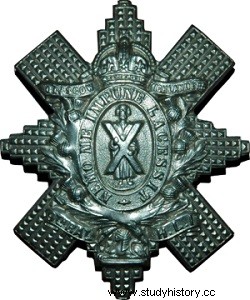
Since the Restoration, there had been Scottish regiments in the British Army, but the Royal Scots could pride themselves on being the oldest; all these Scots were from Lower Scotland. In 1739, to police the Highlands, a first regiment was raised in the north of the country; he gave satisfaction and became the 42nd of the Line, or Royal Highland. During the Seven Years' War further units of Highlanders were raised; they were dissolved at the end of the war. New units of Highlanders were created during the War of Independence and thereafter 2 regiments were kept; it was among others the 71st, already mentioned in connection with the Light Infantry. In 1793, during the conflict with France, this recruitment accelerated, and in 1814 the British Army had 12 regiments of Highlanders (a total of 21 battalions).

In addition to the Highland Light Infantry regiment, 4 units of Highlanders participated in the Battle of Waterloo. These were the 42nd, 73rd, 79th and 90th. The 42nd Regiment was called the Black Watch (Black Guard), because of the color of its kilt. The 73rd (which wore no kilt) was derived from the 2nd Battalion of the 42nd. The 79th and 90th, the Cameron Highlanders and the Gordon Highlanders respectively, consisted of a single battalion. These were units raised at their own expense by wealthy aristocrats, in this case by Alan Cameron of Erracht and by the Marquess of Huntly, later 5th Duke of Gordon. The Duchess of Richmond was Huntly's sister, and Gordon's Highlanders performed highland dances on her June 15 party.
Going back to the Camerons, their regiment was a real family affair. Alan Cameron was colonel of the regiment until his death in 1828. In addition, one of the lieutenant-colonels of the regiment belonged to the clan; this rule undergoes a short exception after the death of Phillip Cameron, killed in Fuentés de Ofioro. At Waterloo, in the Cameron battalion, 8 officers and the quartermaster bore the name of Cameron; 6 of them were wounded.
Highland units wore British Infantry jackets; With the exception of the 73rd, which wore the usual grey-blue infantry trousers and retained the shako, the Scottish regiments were easily recognizable by the colors of their kilts, stockings and berets. The Black Watch tartan was unrelated to any clan colours, but the drum major of that regiment wore the Royal Stuart kilt. Cameron's Highlanders wore their clan's tartan, but Gordon's wore that of the Black Watch, though with a yellow stripe. In service, the Highlanders did not wear the sporran (rawhide pouch). Their stockings were red and white, with black seams, and the garters were made of red braid. The beret consisted of a carcass covered with fabric and surrounded by a strip of Scottish fabric (red, white, green). Starting from the left side, ostrich feathers cascaded over the beret towards the right side. The left side of the beret also bore a distinctive regimental rosette, which held a feather. This feather was in the colors of the company, as in the other regiments. However, the Black Watch wore a red feather in memory of the valor of this unit during the battle of Geldermalsen (in 1795).* This beret was provided with a leather visor, held by ribbons which fell on the neck. Officers did not wear visors.
In the Highlands, officers were identifiable by several details. The crimson sash passed over the left shoulder, held in place by a counter epaulette. In the flank companies, the officers were entitled to the thistle (instead of the hunting horn or the grenade).
Any officer in the field being possibly called upon to mount on horseback, the regulations provided for the replacement of the kilt by trousers, but this prescription was probably little applied. In combat, the wearing of the plaid was prohibited. Despite the prescriptions, the officers wore the broad-bladed saber.
